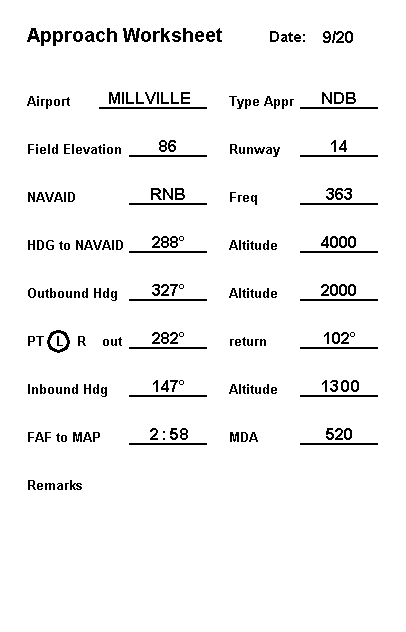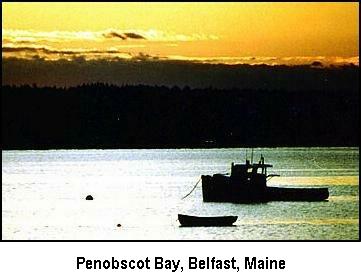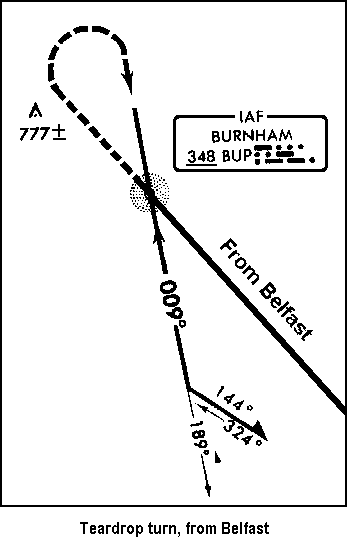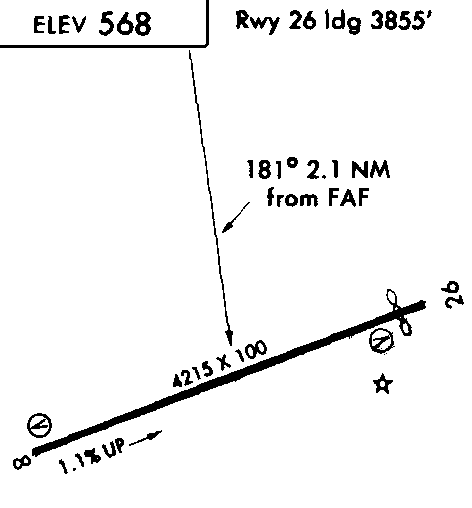NDB Off Field

Wow! Atlantic City entertains like no other destination in the country. Why couldn't the Pageant last all year? This place has thirteen casinos offering 24-hour non-stop action, world-class headline entertainers, bright sandy beaches, a 4½ mile amusement-filled Boardwalk, and championship golf courses.
But after three days Mr. Counter's phone call last night awoke me from a sound sleep. He said to be ready first thing in the morning to fly him and a guest to Millville to recuperate from all of the noise and excitement of Atlantic City. While in Millville, he also wants to explore the natural attractions.
The weather is lousy today ... 800 ft and one mile visibility. Maybe Mr. Counter will change his mind. If the weather gets any lower, Millville will be socked in.
The sound of a car-door slamming turns my head. No, Mr. Counter won't cancel his plans. Here he comes now, struggling with two suitcases under one arm. The other arm is around Miss Natural Attractions' waist.
The Flight
Time to go to work. Yep, we'll use the same Millville approach plate that we just discussed in the previous section. Since you're now very familiar with its features, it makes sense to fly that particular approach.
The first approach will be in a no-wind situation, just to get the feel of it. We're going into a small field, no 747's behind us to irritate if we slow up our C182 Nav Trainer a little way out.
Print the approach plate again, if necessary, by clicking here then we can begin.
Approach Worksheet
Review the information for the approach. I recommend using the Approach Worksheet to get all of the numbers in front of you for quick, easy reference. Click here to print it. Two approaches can be figured with one printout. The worksheet lists information in the order that it is needed.
Lets get the FAF to MAP approach time calculation out of the way first. Assume a 75 kt maneuvering speed for the C182 Nav Trainer. For 3.7 nm, that time would be 2 min., 58 sec. Jot that at the bottom of the Worksheet.

Millville Airport Approach Worksheet
Set the weather on your flight simulator to one mile visibility and cloud cover to 800 ft. MSL "overcast." Set the wind speed to zero knots.
Now fill in the rest of the data on the worksheet. The completed worksheet is shown in the illustration. PT is the Procedure Turn information, Left or Right, and the heading away from the outbound course and the return heading after the 180° turn.
This first flight will originate from Bader Field, KAIY, Atlantic City, New Jersey, where I took my PP check ride a few decades ago. Tune the ADF receiver to 363 KHz, and verify its Morse code identifier (Click the center-portion of radio face). The distance to the Rainbow beacon is 31.5 nm. Calculate the ETE for your C182 Nav Trainer; plan a cruise speed of 110 kts for the calculation. Reset the panel timer to zero.
Leave the aircraft's autopilot in the off position. We're going to fly this route. Print the KAIY to KMIV flight plan.
You may want to refamiliarize yourself on how to intercept an NDB bearing, both inbound and outbound. If so, pause here now to go to that explanation in the NDB navigation section.
Take-off from Runway 29 and start the panel timer. Jog slightly left to intercept the 288° radial from the RNB beacon at Millville, KMIV. Climb to 4000 ft.
A few minutes before your anticipated arrival at the RNB NDB, begin your descent to 2000 feet. Plan on a standard 500 fpm descent. You'll be busy enough during the actual approach that it will be good to get this behind you now.
As the needle begins to swing, announcing arrival at the RNB Beacon, turn right and intercept the 327° outbound bearing. Reset and restart the panel timer. Maintain the 2000 ft. altitude.
When the timer reads two minutes turn left to a heading of 282° for the procedure turn. Reset and restart the timer. Maintain your altitude on the turn. All turns should be a standard-rate, two minutes for 360°.
When the timer again reads two minutes, turn right to 102° to return to the inbound track to the beacon. Reset the panel timer, but don't restart it until intercept of the inbound bearing is complete.
Intercept the 147° bearing with a right turn. Restart the timer after stabilizing your inbound heading. It will be slightly longer inbound to the beacon from the procedure turn, than it was outbound because the procedure turn was away from the airport.
Descend to 1300 ft altitude at 500 fpm. Transition to landing configuration: Slow to a 75 kt approach speed and drop one notch of flaps. Once you reach the FAF, RNB NDB inbound, only one task should remain to occupy your attention: descend to the MDA and fly to the MAP and land.
It's important here to establish the concept of a stabilized approach. The aircraft's configuration should be stabilized before reaching the FAF, i.e., speed reduced to the desired approach speed and flaps properly set. Again, for the C182 Nav Trainer we'll use 75 kts. and one notch of flaps.
As the needle swings on beacon passage inbound, reset and restart the panel timer. Immediately descend to the 520 ft MDA for this approach. At 500 fpm that will eat up about 1:34 of your inbound 2:58 to the MAP. Don't descend an inch or centimeter below the 520 ft MDA. Keep heading and speed constant as you track outbound from the beacon to the runway.
Don't chase the needle if it starts to move. Make small corrections in heading to stop the needle movement and then stay on that heading. Pay close attention to the timer. If everything is OK, continue to the MAP. If you're not happy with the approach, execute the missed approach with a climbing right turn to 2000 ft and return to the beacon. Fly outbound and restart the approach again.
Arriving at the MAP
The minimum visibility for this straight-in approach is one mile. That means that you should clearly spot either the end of the runway or the runway lights about one-mile before reaching the runway. Once they are clearly in view, transition to a normal VFR, straight in landing.
Be aware that the runway threshold, when it appears, may be a few degrees off from straight ahead on your approach. Some wiggling may be necessary to line up to land. Don't lose the ship now.
Also, be advised that if you first spot the runway threshold only a few seconds before the time to MAP has elapsed that you will be 438 feet above the runway. If the runway is 10,000 feet long, not a problem. If it's 3000 feet long, you probably cannot lose that altitude and still have enough runway in front of you to land.
Don't point the nose down and figure "you can make it." More than one captain of a propliner thought the same, ended up folding up the nose gear on touchdown, as well as his career. Go around and try again.
With these thoughts in mind, your landing should be safe and comfortable. Taxi to the gate and buy yourself a well-deserved cup of coffee. Presumably Mr. Counter and Miss Natural Attractions can take care of themselves.
The Teardrop Turn

This next flight presents a different challenge.
Belfast, Maine, KBST, to Pittsfield, Maine, 2B7
I still can't believe it. The Boss had sent me to Belfast, Maine to ferry back a nearly-new C182 Nav Trainer. But it wouldn't be ready for a week and he had told me to take some vacation while waiting for it.
It was a great week in the heart of coastal Maine. I mingled with seafarers, back-to-the-landers, and always-on-the-landers. The high point was visiting the Penobscot Marine Museum, Maine's oldest maritime museum, and famous for its breadth of exhibits
But the week was up, the fun time was over. The Boss had asked me to check in before I left, that he might have a charter for me. It was with foreboding that I lifted the phone. We hadn't heard from Benjamin Counter for some time, now.
"You must have done something right," the Boss said. "Counter recommended us to their principal stockholder, a Mr. Well Thee. Thee needs a hop from Pittsfield, Maine down to Gloucester, Mass. in time to catch the Casino Cruise. Not to worry, I told him. It's only an hour and a half flight—you'd easily have him there before sailing time."
"Thee must be a workaholic, too," the Boss continued. "because, like Benjamin Counter, his administrative assistant will join him to help with the workload when the gaming tables are closed. Beats me how anyone can do any work on a cruise ship with live entertainment that's a floating casino to boot. All I can figure is that those uppity-up people just can't ever get their mind off of business."
The Boss hung up before I could explain that business.
The Flight
Click here to print the NDB approach plate for Pittsfield Muni airport.
Set your weather to 1000 ft overcast and two miles visibility. The wind is calm.
Take-off from Runway 33 at Belfast Municipal airport and pick up the Burnham Beacon (348 KHz, BUP) 23 nm distant. Track inbound on the 338° bearing. You'll notice that your initial arrival at the IAF is broadly inbound to the airport, the opposite direction to begin the approach procedure.

![]() The teardrop turn was invented for just this situation.
The teardrop turn was invented for just this situation.
Fill out the Approach Worksheet for Pittsfield. Just writing the numbers on the form will enhance your memory of them later.
Proceed over the NDB on the 338° track established from Belfast. Altitude should be at or above the 2600 ft. listed for the outbound course of the approach. Note the 777 ft. obstruction very near the flight path. Not a good time to get sloppy on altitude. Drop one notch of flaps and slow to 75 kts.
Don't start the turn back to the NDB so early that you swing too wide. Best to go out a little farther than you think necessary, start the turn, and continue around, intercepting the 189° bearing from the beacon in the conventional manner. Then track to the bearing and you're in great shape to start the approach on station passage because the aircraft heading is already correct.
The teardrop turn is helpful in another way, too. You can determine the wind-correction angle needed on the way to the beacon, and have that under control, too, as you pass the station.

Pittsfield Muni Airport Approach Worksheet
The flight from Belfast to Pittsfield is very short, so fly that route and approach several times until it is under control and you're satisfied with the results.
The Circling Approach

"Yeah, the place where they reenact Washington's crossing every year. I watched it once when I was a kid."
This time it was the Boss. He wanted me in Perkasie ASAP, 30 miles north of Philadelphia, to collect Mr. Counter, to save his bacon. Seems like Counter had to beat a hasty retreat from Millville. As mentally stimulating as Miss Natural Attractions was, she was not totally forthcoming. It turned out that the "Miss" part, although technically correct, was substantively inaccurate. Her Significant Other, a professional wrestler and small at only 287 lbs, was at that very moment looking for "that creep who stole my gurl."

A circling approach is the only option for Pennridge Airport.
So here I was, at Philadelphia Int'l. airport, as close as I could get to Perkasie, waiting for the weather over there to lift. It was less than 30 miles from here to the Pennridge airport. I reviewed their approach plate again and sighed when I glanced at the airport plan view. The approach was broadside to the runway and a circling approach would be necessary.
Three situations can create the need for a circling approach.
- If the instrument approach is not aligned within 30° of the runway heading, as the case in Perkasie.
- If the surface winds make it unsafe to land on the runway that the approach procedure is aligned with.
- If the straight-in approach procedure forces a dangerously high rate of descent, usually a factor of the terrain.
Although the MDA for a circling approach brings the aircraft into the vicinity of the field below normal traffic-pattern altitude, it guarantees 300 ft vertical clearance from all obstacles in the circling area.
Why Perkasie's approach is nearly perpendicular to their only runway is unknown to me. But we have to deal with it.
Print the Perkasie/Pennridge approach plate by clicking here and print the flight information by clicking here, then we can begin.
Since the wind is calm, we'll chose to land on Runway 8.
- It provides the full 4215 ft. to land on. If we were to land on Runway 26, only 3855 ft. is available because of the displaced threshold.
- The traffic pattern is standard left turns, and the approach is better aligned for a left-hand pattern into Runway 8 than flying completely around the airport to enter the left-traffic pattern from the other side.
- Runway 8 has a 1.1% upgrade, which will more rapidly slow the aircraft than the downgrade of Runway 26.
Set the weather on your flight simulator to two miles visibility, wind, calm and the ceiling at 1500 ft, "overcast." The NDB is very close to the field, 2.1 nm, so calculate the time to the MAP at 75 kts (1 min., 41 secs.). Tune your ADF receiver to UKT NDB, 208 kHz.
Just received ATC clearance to leave for Pennridge. Depart Philadelphia Int'l., KPHL, Rwy 35, climb to 4000 ft, direct to UKT, cleared for the approach, Pennridge Airport, N70.
The pertinent information is filled in the worksheet in the illustration.

Pennridge Airport Approach Worksheet
Fly to UKT and start the approach ... down to 2500 ft outbound and to 1800 ft inbound. There is nothing unusual about the approach up to arriving at the FAF inbound. Then things get very busy, very fast.
that airmanship is proved.
Reset the panel timer, and start it at the FAF. Begin your descent immediately to 1240 ft. MDA. That is a 560 ft change in altitude, and the time from the FAF to the MAP is 1 min., 41 secs., so this is not the time to casually reduce altitude.
Keep the traffic pattern in mind as you head towards the runway. On sighting the runway, turn right to 217° to the traffic-pattern entry heading. From this point on, fly a conventional left-traffic pattern and land on Rwy 8, which slopes slightly upgrade.
If you lose sight of the field once you start circling for the desired runway you are required to immediately execute a missed approach.
You may not descend below the MDA while circling until you are in the actual landing phase, i.e., on base leg or final.
You should have fun flying these approaches. You'll become proficient at them much more quickly than you realize which will greatly improve your flying in general. VOR approaches are very similar to NDB approaches, except for the indicator and some fiddling that you have to do with the OBS knob. You'll find the transition quite easy.
When the NDB is on the field, rather than located some distance away as they were here, the approach procedure is significantly different because there is no FAF. Press the NDB on the Field button below to learn the differences in that sort of approach procedure.
Site best viewed at 600 × 800 resolution or higher.
© 1999 – 2002, Charles Wood.

